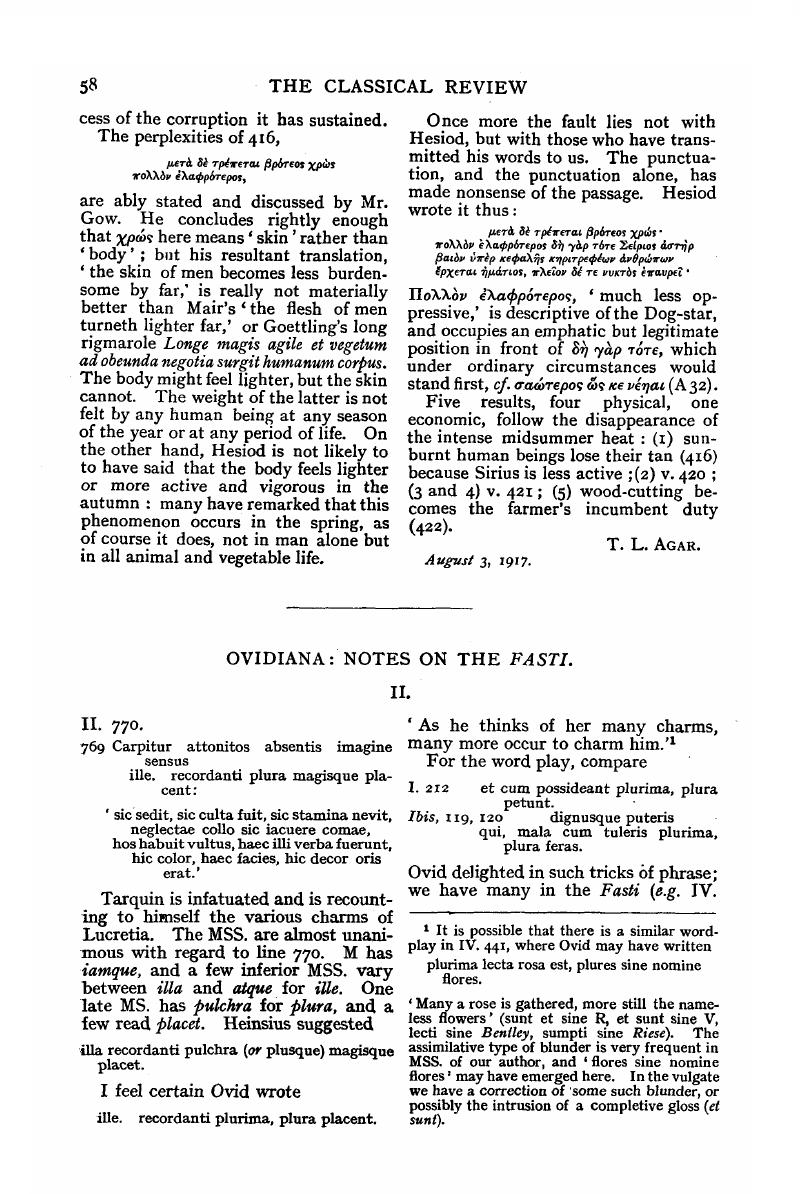No CrossRef data available.
Article contents
Ovidiana: Notes on the Fasti
Published online by Cambridge University Press: 27 October 2009
Abstract

- Type
- Review Article
- Information
- Copyright
- Copyright © The Classical Association 1918
References
page 58 note 1 It is possible that there is a similar wordplay in IV. 441, where Ovid may have written plurima lecta rosa est, plures sine nomine flores.
‘Many a rose is gathered, more still the nameless flowers’ (sunt et sine R, et sunt sine V, lecti sine Benlley, sumpti sine Riese). The assimilative type of blunder is very frequent in MSS. of our author, and ‘flores sine nomine flores’ may have emerged here. In the vulgate we have a correction of some such blunder, or possibly the intrusion of a completive gloss (et sunt).
page 59 note 1 Of course some critics remain unconvinced. Merkel is unable to receive the reading of an inscription (Gruter, 637, 5 CIL. VI. 2 n. 9632) against the MSS. in the Tristia; Ehwald clings still to P's quaerenti in
‘credite: credenti nulla procella nocet’ (Am. II., 11, 21).
page 59 note 2 For plurama from plurima, see Havet, p. 134: plura would drop out after plurama. Thus nube is omitted after nubere (Her. IX. 32) in P, and we have only nubere pari.
page 59 note 3 Merkel's statement that parvus inermis erat is the reading of ‘vett. ed.’ is hardly accurate. Except the Ed. Venet. Rub., such old editions as I have seen read parvus inermis eras.
page 60 note 1 Parvus can hardly be used as a noun, see Burman on II. 385: he forgot this note when he read parvus here.
page 60 note 2 E.g. A.A. II. 557–559 ‘deprendere partite vestras hellip; crescit amor prensis ?’
page 60 note 3 Bacchus made reparation by bringing up Semele from Hades: Diod. IV. 25, Apoll. III. 38, Hyg. Fab. 251. The ascent was through the Alcyonian Lake at Lerna, Paus. II. 37, 5. It is to this descent into Hades that Horace alludes in Ode II. 19, 29. The legend was an old one; Pindar describes Semele living amongst the immortals, Ol. II. 25, Pyth. XI. 1.
page 60 note 4 Prensus inermis is more appropriate than deprensus inermis, for Bacchus is actually caught in the storm of Fire, without resource or helper (cf. A. A. III. 359 ‘ bellatorque suo prensus sine compare bellat’). His plight is somewhat analogous to that of the sailor caught in a sudden squall, ‘ in patenti prensus Aegaeo ’ (Hor. c. II. 16, 2).
page 60 note 5 The warlike side to Dionysus' character is sometimes forgotten, but his followers gloried in it. Infidels scoffed at the defenceless stripling (‘ puer inermis,’ Met. III. 553), and the effeminate debauchee (see Eur. Bacch. 223–238), but he was potent on the battlefield, both as an inspirer of panic (Eur. 301–305) and as a real rival of Ares (Bacchus ‘ Eνυ⋯λιος cognominatur, Macr. I. 19, 2). His triumphs rivalled those of his sire: ‘ Dionysus praeter Iovem solus omnium deorum triumphavit’ (Lact. Inst. I.10, 8). See Brandt's note on A. A., I.190. Most modern editors (except Dr. Gow) differ —perhaps rashly—from Bentley on Hor. c. I. 12, 21, and aseribe to Liber the epithet proeliis audax.
page 60 note 6 I speak with some diffidence on such matters, but see Lindsay, N.L., p. 41 and pp. 215–218.
page 61 note 1 It was the number not the mode of flight which was important. Each vulture signified a saecidum. Professor Housman's ‘Roma supremas desperavit avis ’ (Carm. Bucol. Einsidl. II. 34; see C.Q. IV. 1, p. 47) is certain. On the subject of these auguries, see S. Reinach, Üne prediction accomplie, in C.M.R. III. pp. 303–310.


